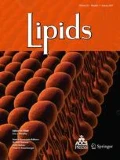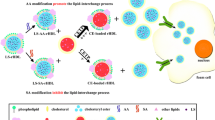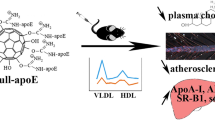Abstract
Apolipoprotein C-III (apoC-III) decreases the apolipoprotein E (apoE)-mediated uptake of lipoprotein remnants by the liver, and a high plasma concentration of apoC-III in VLDL is associated with hypertriglyceridemia and the risk of coronary heart disease. In this study, we prepared lipid emulsions containing triolein, phosphatidylcholine and cholesterol as model particles of lipoproteins, and examined the roles of apoC-III in apoE-mediated uptake of emulsions by HepG2 cells. Cholesterol in emulsion particles enhanced the apoE-mediated uptake via heparan sulfate proteoglycan and LDL receptor-related protein pathways. The amount of apoE bound to emulsion particles was increased by the presence of cholesterol at the particle surface, whereas cholesterol had no effect on the binding amount of apoC-III. Surface cholesterol alleviated the inhibitory effect of apoC-III on apoE incorporation into the emulsion surface. However, ApoC-III almost completely inhibited the apoE-mediated uptake of cholesterol-containing emulsions despite sufficient binding of apoE to emulsions. These findings suggest that apoC-III attenuates the binding of apoE to the lipoprotein surface and apoE-mediated cellular uptake of lipoprotein remnants. Furthermore, cholesterol may affect these functions of apoC-III and apoE involved in the clearance of lipoprotein remnants.






Similar content being viewed by others
Abbreviations
- apoC-III:
-
Apolipoprotein C-III
- apoE:
-
Apolipoprotein E
- HSPG:
-
Heparan sulfate proteoglycan
- LRP:
-
LDL receptor-related protein
- PL:
-
Phospholipid
- PMC oleate:
-
Pyrenemethyl 3β-(cis-9-octadecenoyloxy)-22,23-bisnor-5-cholenate
- PtdCho:
-
Phosphatidylcholine
- TAG:
-
Triacylglycerol
References
Luc G, Fievet C, Arveiler D, Evans AE, Bard JM, Cambien F, Fruchart JC, Ducimetiere P (1996) Apolipoproteins C-III and E in apoB- and non-apoB-containing lipoproteins in two populations at contrasting risk for myocardial infarction: the ECTIM study. Etude Cas Temoins sur ‘Infarctus du Myocarde. J Lipid Res 37:508–517
Sacks FM, Alaupovic P, Moye LA, Cole TG, Sussex B, Stampfer MJ, Pfeffer MA, Braunwald E (2000) VLDL, apolipoproteins B, CIII, and E, and risk of recurrent coronary events in the cholesterol and recurrent events (CARE) trial. Circulation 102:1886–1892
Lee SJ, Campos H, Moye LA, Sacks FM (2003) LDL containing apolipoprotein CIII is an independent risk factor for coronary events in diabetic patients. Arterioscler Thromb Vasc Biol 23:853–858
Lee SJ, Moye LA, Campos H, Williams GH, Sacks FM (2003) Hypertriglyceridemia but not diabetes status is associated with VLDL containing apolipoprotein CIII in patients with coronary heart disease. Atherosclerosis 167:293–302
Chan DC, Watts GF, Nguyen MN, Barrett PH (2006) Apolipoproteins C-III and A-V as predictors of very-low-density lipoprotein triglyceride and apolipoprotein B-100 kinetics. Arterioscler Thromb Vasc Biol 26:590–596
Mendivil CO, Zheng C, Furtado J, Lel J, Sacks FM (2010) Metabolism of very-low-density lipoprotein and low-density lipoprotein containing apolipoprotein C-III and not other small apolipoproteins. Arterioscler Thromb Vasc Biol 30:239–245
Zheng C, Khoo C, Furtado J, Sacks FM (2010) Apolipoprotein C-III and the metabolic basis for hypertriglyceridemia and the dense low-density lipoprotein phenotype. Circulation 121:1722–1734
Pollin TI, Damcott CM, Shen H, Ott SH, Shelton J, Horenstein RB, Post W, McLenithan JC, Bielak LF, Peyser PA, Mitchell BD, Miller M, O’Connell JR, Shuldiner AR (2008) A null mutation in human APOC3 confers a favorable plasma lipid profile and apparent cardioprotection. Science 322:1702–1705
Atzmon G, Rincon M, Schechter CB, Shuldiner AR, Lipton RB, Bergman A, Barzilai N (2006) Lipoprotein genotype and conserved pathway for exceptional longevity in humans. PLoS Biol 4:e113
Petersen KF, Dufour S, Hariri A, Nelson-Williams C, Foo JN, Zhang XM, Dziura J, Lifton RP, Shulman GI (2010) Apolipoprotein C3 gene variants in nonalcoholic fatty liver disease. N Engl J Med 362:1082–1089
Saito H, Lund-Katz S, Phillips MC (2004) Contributions of domain structure and lipid interaction to the functionality of exchangeable human apolipoproteins. Prog Lipid Res 43:350–380
Zhang SH, Reddick RL, Piedrahita JA, Maeda N (1992) Spontaneous hypercholesterolemia and arterial lesions in mice lacking apolipoprotein E. Science 258:468–471
Plump AS, Smith JD, Hayek T, Aalto-Setala K, Walsh A, Verstuyft JG, Rubin EM, Breslow JL (1992) Severe hypercholesterolemia and atherosclerosis in apolipoprotein E-deficient mice created by homologous recombination in ES cells. Cell 71:343–353
Batal R, Tremblay M, Barrett PH, Jacques H, Fredenrich A, Mamer O, Davignon J, Cohn JS (2000) Plasma kinetics of apoC-III and apoE in normolipidemic and hypertriglyceridemic subjects. J Lipid Res 41:706–718
Krauss RM (1998) Atherogenicity of triglyceride-rich lipoproteins. Am J Cardiol 81:13B–17B
de Silva HV, Lauer SJ, Wang J, Simonet WS, Weisgraber KH, Mahley RW, Taylor JM (1994) Overexpression of human apolipoprotein C-III in transgenic mice results in an accumulation of apolipoprotein B48 remnants that is corrected by excess apolipoprotein E. J Biol Chem 269:2324–2335
Masucci-Magoulas L, Goldberg IJ, Bisgaier CL, Serajuddin H, Francone OL, Breslow JL, Tall AR (1997) A mouse model with features of familial combined hyperlipidemia. Science 275:391–394
van Dijk KW, Rensen PC, Voshol PJ, Havekes LM (2004) The role and mode of action of apolipoproteins CIII and AV: synergistic actors in triglyceride metabolism? Curr Opin Lipidol 15:239–246
Kowal RC, Herz J, Weisgraber KH, Mahley RW, Brown MS, Goldstein JL (1990) Opposing effects of apolipoproteins E and C on lipoprotein binding to low density lipoprotein receptor-related protein. J Biol Chem 265:10771–10779
Sehayek E, Eisenberg S (1991) Mechanisms of inhibition by apolipoprotein C of apolipoprotein E-dependent cellular metabolism of human triglyceride-rich lipoproteins through the low density lipoprotein receptor pathway. J Biol Chem 266:18259–18267
Morita SY, Okuhira K, Tsuchimoto N, Vertut-Doi A, Saito H, Nakano M, Handa T (2003) Effects of sphingomyelin on apolipoprotein E- and lipoprotein lipase-mediated cell uptake of lipid particles. Biochim Biophys Acta 1631:169–176
Sakurai A, Morita SY, Wakita K, Deharu Y, Nakano M, Handa T (2005) Effects of cholesterol in chylomicron remnant models of lipid emulsions on apoE-mediated uptake and cytotoxicity of macrophages. J Lipid Res 46:2214–2220
Morita SY, Kawabe M, Sakurai A, Okuhira K, Vertut-Doi A, Nakano M, Handa T (2004) Ceramide in lipid particles enhances heparan sulfate proteoglycan and low density lipoprotein receptor-related protein-mediated uptake by macrophages. J Biol Chem 279:24355–24361
Heuser JE, Anderson RG (1989) Hypertonic media inhibit receptor-mediated endocytosis by blocking clathrin-coated pit formation. J Cell Biol 108:389–400
Denicola A, Batthyany C, Lissi E, Freeman BA, Rubbo H, Radi R (2002) Diffusion of nitric oxide into low density lipoprotein. J Biol Chem 277:932–936
Vogel T, Weisgraber KH, Zeevi MI, Ben-Artzi H, Levanon AZ, Rall SC Jr, Innerarity TL, Hui DY, Taylor JM, Kanner D, Yavin Z, Amit B, Aviv H, Gorecki M, Mahley RW (1985) Human apolipoprotein E expression in Escherichia coli: structural and functional identity of the bacterially produced protein with plasma apolipoprotein E. Proc Natl Acad Sci USA 82:8696–8700
Tajima S, Yokoyama S, Yamamoto A (1983) Effect of lipid particle size on association of apolipoproteins with lipid. J Biol Chem 258:10073–10082
Morita SY, Nakano M, Sakurai A, Deharu Y, Vertut-Doi A, Handa T (2005) Formation of ceramide-enriched domains in lipid particles enhances the binding of apolipoprotein E. FEBS Lett 579:1759–1764
Mahley RW, Ji ZS (1999) Remnant lipoprotein metabolism: key pathways involving cell-surface heparan sulfate proteoglycans and apolipoprotein E. J Lipid Res 40:1–16
Ji ZS, Sanan DA, Mahley RW (1995) Intravenous heparinase inhibits remnant lipoprotein clearance from the plasma and uptake by the liver: in vivo role of heparan sulfate proteoglycans. J Lipid Res 36:583–592
Ji ZS, Mahley RW (1994) Lactoferrin binding to heparan sulfate proteoglycans and the LDL receptor-related protein. Further evidence supporting the importance of direct binding of remnant lipoproteins to HSPG. Arterioscler Thromb 14:2025–2031
Curtiss LK, Boisvert WA (2000) Apolipoprotein E and atherosclerosis. Curr Opin Lipidol 11:243–251
Jong MC, Hofker MH, Havekes LM (1999) Role of ApoCs in lipoprotein metabolism: functional differences between ApoC1, ApoC2, and ApoC3. Arterioscler Thromb Vasc Biol 19:472–484
Morita SY, Kawabe M, Nakano M, Handa T (2003) Pluronic L81 affects the lipid particle sizes and apolipoprotein B conformation. Chem Phys Lipids 126:39–48
Morita SY, Deharu Y, Takata E, Nakano M, Handa T (2008) Cytotoxicity of lipid-free apolipoprotein B. Biochim Biophys Acta 1778:2594–2603
Liu H, Talmud PJ, Lins L, Brasseur R, Olivecrona G, Peelman F, Vandekerckhove J, Rosseneu M, Labeur C (2000) Characterization of recombinant wild type and site-directed mutations of apolipoprotein C-III: lipid binding, displacement of ApoE, and inhibition of lipoprotein lipase. Biochemistry 39:9201–9212
Gangabadage CS, Zdunek J, Tessari M, Nilsson S, Olivecrona G, Wijmenga SS (2008) Structure and dynamics of human apolipoprotein CIII. J Biol Chem 283:17416–17427
Westerlund JA, Weisgraber KH (1993) Discrete carboxyl-terminal segments of apolipoprotein E mediate lipoprotein association and protein oligomerization. J Biol Chem 268:15745–15750
Sakamoto T, Tanaka M, Vedhachalam C, Nickel M, Nguyen D, Dhanasekaran P, Phillips MC, Lund-Katz S, Saito H (2008) Contributions of the carboxyl-terminal helical segment to the self-association and lipoprotein preferences of human apolipoprotein E3 and E4 isoforms. Biochemistry 47:2968–2977
Wilson C, Wardell MR, Weisgraber KH, Mahley RW, Agard DA (1991) Three-dimensional structure of the LDL receptor-binding domain of human apolipoprotein E. Science 252:1817–1822
Croy JE, Brandon T, Komives EA (2004) Two apolipoprotein E mimetic peptides, ApoE(130–149) and ApoE(141–155)2, bind to LRP1. Biochemistry 43:7328–7335
Guttman M, Prieto JH, Handel TM, Domaille PJ, Komives EA (2010) Structure of the minimal interface between ApoE and LRP. J Mol Biol 398:306–319
Saito H, Dhanasekaran P, Nguyen D, Baldwin F, Weisgraber KH, Wehrli S, Phillips MC, Lund-Katz S (2003) Characterization of the heparin binding sites in human apolipoprotein E. J Biol Chem 278:14782–14787
Sivashanmugam A, Wang J (2009) A unified scheme for initiation and conformational adaptation of human apolipoprotein E N-terminal domain upon lipoprotein binding and for receptor binding activity. J Biol Chem 284:14657–14666
Lund-Katz S, Zaiou M, Wehrli S, Dhanasekaran P, Baldwin F, Weisgraber KH, Phillips MC (2000) Effects of lipid interaction on the lysine microenvironments in apolipoprotein E. J Biol Chem 275:34459–34464
Lund-Katz S, Wehrli S, Zaiou M, Newhouse Y, Weisgraber KH, Phillips MC (2001) Effects of polymorphism on the microenvironment of the LDL receptor-binding region of human apoE. J Lipid Res 42:894–901
Yamamoto T, Ryan RO (2006) Role of leucine zipper motif in apoE3 N-terminal domain lipid binding activity. Biochim Biophys Acta 1761:1100–1106
Ben-Yashar V, Barenholz Y (1991) Characterization of the core and surface of human plasma lipoproteins. A study based on the use of five fluorophores. Chem Phys Lipids 60:1–14
Redgrave TG, Small DM (1979) Quantitation of the transfer of surface phospholipid of chylomicrons to the high density lipoprotein fraction during the catabolism of chylomicrons in the rat. J Clin Invest 64:162–171
Windler EE, Preyer S, Greten H (1986) Influence of lysophosphatidylcholine on the C-apolipoprotein content of rat and human triglyceride-rich lipoproteins during triglyceride hydrolysis. J Clin Invest 78:658–665
Maranhao RC, Tercyak AM, Redgrave TG (1986) Effects of cholesterol content on the metabolism of protein-free emulsion models of lipoproteins. Biochim Biophys Acta 875:247–255
Saito H, Minamida T, Arimoto I, Handa T, Miyajima K (1996) Physical states of surface and core lipids in lipid emulsions and apolipoprotein binding to the emulsion surface. J Biol Chem 271:15515–15520
Redgrave TG, Vassiliou GG, Callow MJ (1987) Cholesterol is necessary for triacylglycerol-phospholipid emulsions to mimic the metabolism of lipoproteins. Biochim Biophys Acta 921:154–157
Aalto-Setala K, Fisher EA, Chen X, Chajek-Shaul T, Hayek T, Zechner R, Walsh A, Ramakrishnan R, Ginsberg HN, Breslow JL (1992) Mechanism of hypertriglyceridemia in human apolipoprotein (apo) CIII transgenic mice. Diminished very low density lipoprotein fractional catabolic rate associated with increased apo CIII and reduced apo E on the particles. J Clin Invest 90:1889–1900
Narayanaswami V, Ryan RO (2000) Molecular basis of exchangeable apolipoprotein function. Biochim Biophys Acta 1483:15–36
Clavey V, Lestavel-Delattre S, Copin C, Bard JM, Fruchart JC (1995) Modulation of lipoprotein B binding to the LDL receptor by exogenous lipids and apolipoproteins CI, CII, CIII, and E. Arterioscler Thromb Vasc Biol 15:963–971
Acknowledgments
This work was supported in part by Grants-in-Aid for Scientific Research and Young Scientists from the Japanese Ministry of Education, Culture, Sports, Science, and Technology (17390011 and 22790053), by the Program for the Promotion of Fundamental Studies in Health Science (04-8) of the National Institute of Biomedical Innovation (NIBIO), and a grant from Research Fellowships of the Japan Society for the Promotion of Science for Young Scientists.
Author information
Authors and Affiliations
Corresponding author
About this article
Cite this article
Morita, Sy., Sakurai, A., Nakano, M. et al. Presence of Apolipoprotein C-III Attenuates Apolipoprotein E-Mediated Cellular Uptake of Cholesterol-Containing Lipid Particles by HepG2 Cells. Lipids 46, 323–332 (2011). https://doi.org/10.1007/s11745-010-3498-9
Received:
Accepted:
Published:
Issue Date:
DOI: https://doi.org/10.1007/s11745-010-3498-9




